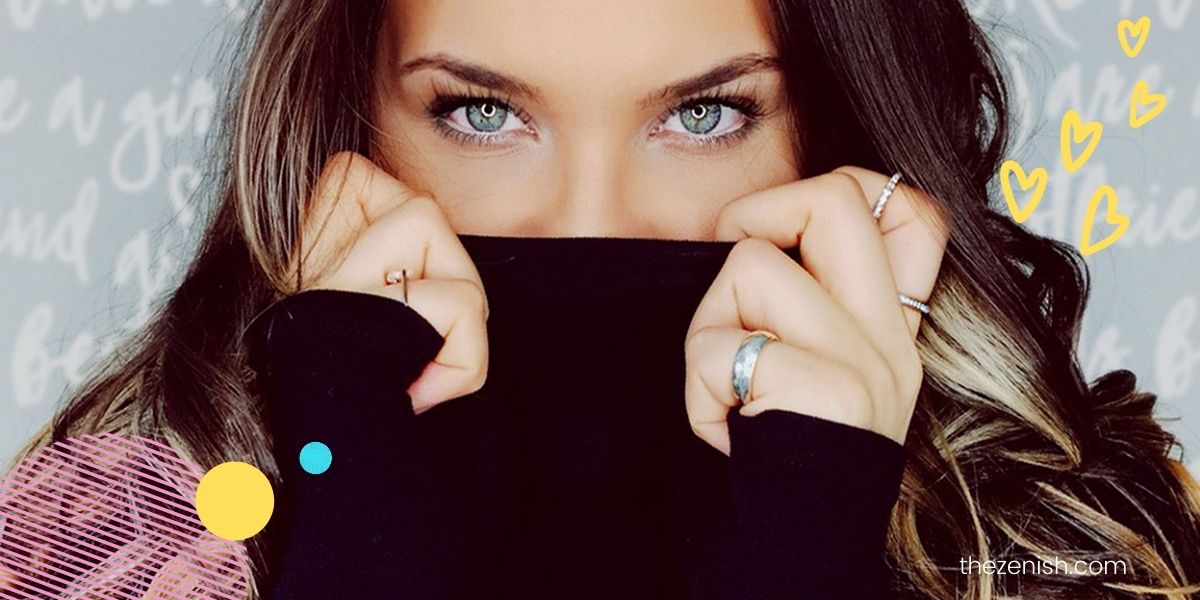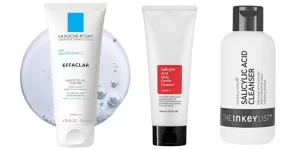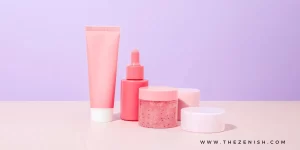
Acne, pimple, zit, breakout, papule, etc so many names but what are they? And aren’t they all just different types of pimples?
Well turns out that no they’re not all the same. There are several different types of acne (aka pimples) and they require different treatment options, but knowing the difference isn’t always easy.

Step one on your clear skin journey is learning to identify the type of acne you have. Learning how they form, what they look like, and what you can do to treat them.
| this post may contain affiliate links, which means if you purchase from one of these links, I may receive a small commission at no additional cost to you. |
1. Whiteheads
Also known as “closed comedones,” whiteheads are one of the most common types of pimples. They look like small white bumps.
Whiteheads form when your pores get clogged with dead skin cells and sebum then gets covered by a layer of skin and develops pus inside.
It’s always tempting to pop all types of pimples but don’t. Picking and popping whiteheads just spread bacteria to the surrounding pores.
Instead, try an over-the-counter (OTC) treatment like sulphur, salicylic acid, or benzoyl peroxide.
2. Blackheads
Also called “open comedones,” blackheads look like dark spots in your skin and are caused by clogged pores open to the air. It looks black because the clogs change colour when exposed to oxygen.
Seeing a dermatologist get an extraction is one way to deal with blackheads, but for long-term results, it’s better to keep your pores clear with regular cleansing and exfoliation.
3. Papules
Acne papules are swollen red bumps that form when a buildup of oil and dead skin cells clog your pores. Pressure then causes the walls of your pore to rupture, spreading bacteria into the surrounding skin.
Your immune system responds with inflammation, making papules look red and swollen. To reduce swelling calming any inflammation is crucial.
Over-the-counter (OTC) benzoyl peroxide is often effective for treating papules (and other inflammatory acne) because it’s antibacterial.
4. Pustules
Pustules are papules that fill up with pus when your immune system kicks in and can form anywhere on your body but are most common on your face, chest and back. The pus swells the bumps and makes the tops look white or yellow.
The best way to prevent pustules is by balancing the amount of oil on your skin, oil is necessary and healthy but too much can lead to breakouts.
Bear in mind that less oil doesn’t mean you should skip moisturizer because skipping moisturizer can make you oily. So be sure your skincare routine includes lots of skin-friendly hydration!
5. Nodules
Nodules are a more severe form of acne that can look like papules but are deeper in your skin where they’re hard to treat and almost impossible to pop.
They look like skin-coloured bumps, and never have that white or yellow part like whiteheads and pustules. They usually feel firm and are painful to the touch.
Nodular acne is tough to treat so it’s better to prevent them before they start and the best way to do that is by staying consistent with your skincare routine.
If you already have nodules and they’re sore, you can find some relief with a cold compress. The cold will help reduce any inflammation and ease the pressure on your nerves. But whatever you do, don’t try and pop them! That will only increase inflammation and cause scarring.
6. Cysts
Cystic acne is the most severe type of acne and forms from an infection deep within the skin. They look like deep, red lumps, are filled with pus and feel soft to the touch. They’re often very tender and painful to the touch and are more common on the face, jawline and back.
Cysts are stubborn and tend to linger for weeks or even months. This type of acne, scars very easily so don’t pop it.
And try not to pick at them, that can spread the infection and create even more cysts. And most importantly follow a balanced and healthy skincare routine to prevent future breakouts.
Cystic acne is difficult to treat but your dermatologist can help with medications, retinoids, antibiotics and certain birth control pills (for women).
7. Milia (not a type of pimple but still one to know)
Milia (sometimes known as “milia seeds”) aren’t acne but are often confused for pimples so I’ve added them to the list. Chances are if you’re Google-ing (types of pimples) they’ll pop up.
Milia are small, light bumps that form around your nose, cheeks, and eyes and are typically caused by trapped skin flakes or keratin deposits (the protein that keeps your hair, skin, and nails strong).
You don’t need to do anything to get rid of milia because it usually disappears on its own after a few months. But here’s what you can do to speed up the process:
- Use a mild hydrating cleanser
- Try face steam to help dilate your pores
- Try to avoid picking at milia because it can lead to irritation and scarring
- exfoliate 2-3 times a week
Final thoughts
Who knew there were so many different types of pimples? From cysts, nodules, papules, and pustules there are many different types and they all require different treatment.
And that’s why you need to be able to identify the type of acne you have. When you know what you’re dealing with it’s easier to treat and you can get to clear glowing skin sooner.



